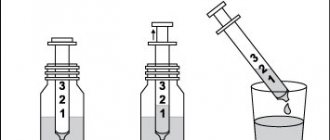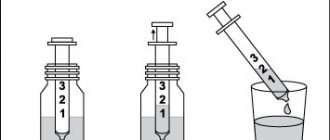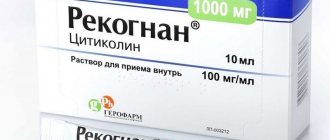Pharmacological properties of the drug Ceraxon
Citicoline stimulates the biosynthesis of structural phospholipids in neuronal membranes, which improves membrane function, including the functioning of ion exchange pumps and neuroreceptors. Due to its stabilizing effect on the membrane, citicoline has anti-edematous properties and reduces cerebral edema. Citicoline reduces the severity of symptoms of cerebral dysfunction after pathological processes such as traumatic brain injury or acute cerebrovascular accidents. Citicoline reduces the level of amnesia, improves the condition of cognitive, sensory and motor disorders, and also weakens the severity of symptoms that are observed with hypoxia and cerebral ischemia, including memory impairment, emotional lability, and impaired ability to perform normal self-care activities. Citicoline is a natural compound found in the human body, so classical pharmacokinetic studies cannot be performed due to the difficulty of quantifying exogenous and endogenous citicoline. During a pharmacokinetic study, its almost complete absorption in the gastrointestinal tract was determined - less than 1% of the dose taken was detected in the feces within 5 days after taking the drug. Two peaks of radioactivity were also noted in the blood plasma, due to metabolism in the liver and intestines: the first - after 1 hour, the second - after 24 hours. Bioavailability by oral and parenteral routes of administration is almost the same. Excretion is very slow, mainly through the respiratory system and urine. After 5 days of administration, about 16% of the drug dose was detected, which indicates the inclusion of the rest of the dose in metabolic processes.
Ceraxon oral solution 100 mg/ml 10 ml sachets 10 pcs
Pharmacological group:
Nootropic drug.
Pharmacodynamics:
Citicoline, being a precursor of key ultrastructural components of the cell membrane (mainly phospholipids), has a wide spectrum of action - it promotes the restoration of damaged cell membranes, inhibits the action of phospholipases, prevents the excessive formation of free radicals, and also prevents cell death by affecting the mechanisms of apoptosis. In the acute period of stroke, citicoline reduces the volume of brain tissue damage and improves cholinergic transmission. In case of traumatic brain injury, it reduces the duration of post-traumatic coma and the severity of neurological symptoms, in addition, it helps to reduce the duration of the recovery period. In chronic cerebral hypoxia, citicoline is effective in the treatment of cognitive disorders such as memory impairment, lack of initiative, and difficulties in performing daily activities and self-care. Increases the level of attention and consciousness, and also reduces the manifestation of amnesia. Citicoline is effective in the treatment of sensory and motor neurological disorders of degenerative and vascular etiology.
Pharmacokinetics:
Suction
Citicoline is well absorbed when taken orally. Absorption after oral administration is almost complete, and bioavailability is approximately the same as after intravenous administration.
Metabolism
The drug is metabolized in the intestines and liver with the formation of choline and cytidine. After administration, the concentration of choline in the blood plasma increases significantly.
Distribution
Citicoline is widely distributed in brain structures, with rapid incorporation of choline fractions into structural phospholipids and cytidine fractions into cytidine nucleotides and nucleic acids. Citicoline penetrates the brain and is actively incorporated into cellular, cytoplasmic and mitochondrial membranes, forming part of the fraction of structural phospholipids.
Removal
Only 15% of the administered dose of citicoline is excreted from the human body: less than 3% by the kidneys and through the intestines and about 12% by exhaled CO2. The excretion of citicoline in urine can be divided into 2 phases: a first phase, lasting about 36 hours, during which the rate of excretion decreases rapidly, and a second phase, during which the rate of excretion decreases much more slowly. The same thing is observed in exhaled CO2 - the rate of elimination decreases rapidly after about 15 hours, and then decreases much more slowly.
Use of the drug Ceraxon
The solution for oral use in adults is prescribed 200 mg (2 ml) orally 3 times a day. For children, the drug can be prescribed orally from the moment of birth - 100 mg (1 ml) 2-3 times a day. The duration of treatment depends on the severity of the brain damage. The minimum recommended period is 45 days. The dose of the drug and the duration of treatment can be changed by the doctor. The drug, pre-mixed with a small amount of water, is taken using a dosing syringe. It is necessary to rinse the dosing syringe with water after each use. IV or IM administration In acute and emergency conditions, the maximum therapeutic effect is achieved when the drug is administered in the first 24 hours. IV is administered slowly (injection duration - 5 minutes) or drip (infusion rate - 40-60 drops per minute) . Treatment begins with prescribing the drug for the first 2 weeks, 500–1000 mg (depending on the patient’s condition) 2 times a day intravenously. Then - 500–1000 mg 2 times a day IM. The maximum daily dose is 2000 mg. If necessary, treatment is continued with the drug in the form of an oral solution. The recommended duration of treatment, at which the maximum therapeutic effect is noted, is 12 weeks. It is recommended for children to prescribe Ceraxon in the form of a solution for oral use.
special instructions
Treatment with Cerakson is often prescribed to premature babies and newborns with brain tissue injuries received during childbirth. The treatment regimen is determined by the attending physician and depends on the Apgar assessment of the child’s condition. Storing the medicine in the refrigerator may cause crystals to form in the solution. It will take at least two months at room temperature to dissolve them. Despite the fact that this does not reduce the quality of the active substance, the drug should still be stored at room temperature not exceeding +30 C.
The empty packaging of the drug must be used within three years from the date of release.
Special instructions for the use of the drug Ceraxon
There are no age restrictions for oral use of the drug. Pregnancy and lactation Although no evidence of risk to the fetus has been obtained when using the drug, during pregnancy the drug is used only when the expected benefit outweighs the potential risk. There are no data on the passage of citicoline into breast milk and its effect on the fetus is unknown. Effect on the ability to drive vehicles and operate complex mechanisms. Citicoline does not affect the ability to drive vehicles and operate complex mechanisms.
Application area
Ceraxon is prescribed for various types of neurological diseases. The doctor calculates the dosage and duration of treatment based on the individual characteristics of the patient. The use of the medicine is designed for a wide range of pathologies. Indicated for recovery from head injuries in the acute phase, strokes of varying severity and elimination of the consequences of pathology. Taken for diseases that cause cognitive disorders of the brain.
The cognitive functions of the brain are aimed at understanding the world around us. The purpose is to collect and analyze information, increase knowledge and think critically about it. When cognitive functions are impaired, a person loses social significance and usefulness. He falls out of objective reality, which threatens a complete lack of independence in matters of life. Cognitive disorders include diseases that cause memory loss, problems with concentration, and problems with analytical thinking.
Cerakson belongs to the group of nootropic drugs and has a beneficial effect on higher nervous activity in humans. Improves metabolism in brain tissue, saturates it with oxygen and must contain a composition suitable for human consumption.
After a course of treatment, patients leave reviews about the medicine and thank the creators for their work.
Contraindications
There are a number of contraindications that the doctor must take into account when prescribing the drug.
Vagotonia
The activity of organs, regulation of the activity of blood vessels and endocrine glands is controlled by the vagus nerve. With vagotonia, the state of the vagus nerve is characterized by excessive tone, which leads to unpleasant consequences: slow heartbeat, increased activity of the stomach and intestines, etc. The disease is severe, diagnosis is difficult due to the presence of several dozen possible symptoms similar to other diseases.
Age up to 18 years
The contraindication is due to the lack of sufficient clinical studies confirming the safety of use in childhood and adolescence.
Intolerance and hypersensitivity to components
These types of contraindications are hereditary.
Prescribed with caution to women if there is pregnancy and a corresponding indication, when the positive effect of the drug outweighs the risk of negative consequences. The drug does not have sufficient clinical data on safety for this group of patients. Doctors recommend stopping breastfeeding for the period of admission.
Compound
The main active ingredient of Ceraxon is citicoline. A drug based on citicoline affects neuropeptides, a type of protein that is formed by the central or peripheral nervous system to control life processes in the body.
Excipients are:
- Sorbitol is a drug that has a pronounced therapeutic effect.
- Glycerol – helps lower and normalize blood pressure.
- Methyl parahydroxybenzoate is an antimicrobial substance.
- Propyl parahydroxybenzoate is an antimicrobial substance.
- Sodium citrate dihydrate is an anticoagulant that prevents the formation of blood clots.
The remaining excipients included in Ceraxon act as flavoring additives.
Release form
Solution for oral administration and injection. The specific form is prescribed based on medical indicators, the degree and phase of neglect of the pathology, the patient’s condition, and concomitant diseases. The difference lies in the concentration of the active substance and the speed at which the healing process begins. With intravenous administration, the rate of delivery of the medicinal substance is higher than when taking the solution orally. When administered intravenously, the drug instantly spreads throughout the body through the bloodstream. It is sold based on a doctor's prescription.
Ceraxon and alcohol
As can be seen from the description, Ceraxon is widely used in neurology and is prescribed for the treatment of a wide range of people. Alcohol is often used in a person's social life. For most people, it is disappointing that they will need to change their routine during the healing period.
The effect of alcohol on the activity of the central nervous system and brain
When drinking alcohol, nerve cells lose tone and fibers are not restored. Negative changes begin in the human brain. The left and right hemispheres, losing nerve connections and cells, change their size to a smaller one, and the convolutions become thinner.
The sensitivity of the nervous system is dulled. A characteristic syndrome of the pathology is a tingling sensation in the tips of the fingers and toes.
Ethanol is detrimental to higher nervous activity. Under the influence of alcohol, a person loses the ability to objectively evaluate his actions and imagine the consequences. A change in reality can be such a vivid experience that a person develops hallucinations due to alcohol intoxication.





